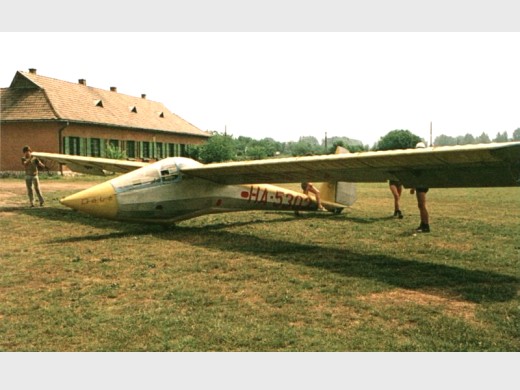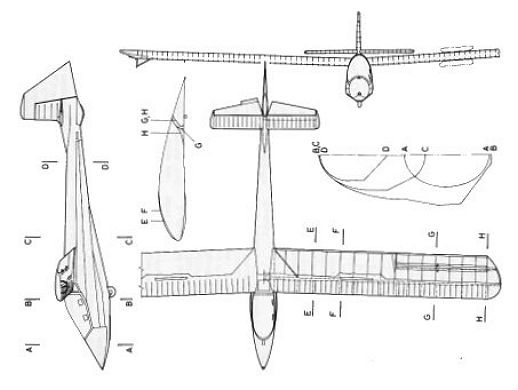
Rubik R-26 P2 Góbé
| DONNÉES GÉNÉRALES |
| Année du premier vol (ou de design, si seul projet) |
1961 |
| Pays | Hongrie |
| Designer(s) | RUBIK, Ernõ |
| Premier constructeur | |
| Type d'appareil | Planeur |
| Fonction | Initiation |
| SPÉCIFICATIONS TECHNIQUES |
| Envergure | 14 m |
| Longueur | -- |
| Hauteur | -- |
| Allongement | -- |
| Surface alaire | -- |
| Profil aile | -- |
| Masse à vide | -- |
| Masse maxi | -- |
| Charge alaire | -- |
| Vitesse mini | -- |
| Vitesse maxi | -- |
| Finesse maxi | |
| Taux de chute mini | -- |
| Nb sièges | 2 |
| Structure | -- |
AUTRES INFORMATIONS
| Constructeur(s) |
| ||||||
| Infos techniques | -- | ||||||
| Histoire résumée | Deuxième prototype du R-26, premier vol en 1961. Le modèle de série sera le R-26 S. In 1958 the MHS, the central organization controlling all flying sports in Hungary, placed an order with the Esztergom Facility of Pest Area Machine Factory (PGE) (formerly Sportárutermelõ V., Esztergom) to design and produce a two-seater glider for basic instruction, a single-seat training and a single-seat standard-class performance glider. The specification called for all-light-metal structures, easy and common maintenance characteristics as well as similar flight characteristics. The concept of the three gliders was based on the - design, production as well as operational - experiences gained with the R-23 Gébics. The design work aimed for as much common assemblies and parts as possible, and for common production technology. The first design, the standard class glider was the R-25 Mokány and the second design was the two-seater for basic instruction, the production version of which got the designation of R-26S and the name of "Góbé" (nickname for a Hungarian from Eastern Transylvania). Two prototypes were built. The structure of the first prototype, the R-26 P1, was similar to that of the R-23 Gébics. The Frise-type ailerons had unusually small area. The front part of the fuselage was covered with light metal sheets as on the Mokány. The landing gear consisted of a spring suspended fixed gear located behind the c.g. of the empty glider, and a nose skid streamlined into the fuselage's bottom. The tail unit had all-flying V surfaces with mass balancing. On the trailing edges of the control surfaces Flettner-type tabs were fitted. To maintain the structural integrity of the wings bat-like airbrakes were fitted on the sides of the fuselage under the wings. This prototype first flew at May 6, 1960. The second prototype, the R-26 P2, had similar wing structure and arrangement as that of the P1 version, however DFS-type airbrakes were fitted working on both surfaces of the wing. The form and structure of the fuselage had got a new form and structure, which was later used on the production version. The tail unit had traditional arrangement. The horizontal surfaces were positioned above the fuselage on the vertical stabilizer to get better spin behavior. The rudder had a large balancing area. The elevator was balanced aerodynamically and had mass-balance as well. This version first flew at August 23, 1961. Both versions underwent a rigorous test and performance measurement program similar to the program applied to the R-25 Mokány. Following the test flights, both versions served at aero clubs to gain operational experiences. Based on the evaluation of these experiences the design of the production version was prepared. The first production glider, which got the designation R-26S, first flew at Jun 6, 1963. Altogether 115 Góbé were produced in Esztergom. Based on this glider a new dual-control instruction system was developed in Hungary, which is in use even today (2004). The production of the R-26S Góbé was closed down at Esztergom. The factory had overhauled R-26S gliders for a couple of years, but in the middle of the 70s even this activity was closed down. In 1981 the XII. AFIT Car Repair Factory at Szombathely established a new workshop and started overhauling R-26S gliders. The factory had modified certain structural elements on the glider to meet European and American requirements and started the production of the modified R-26SU Góbé '82 glider. The first production glider first flew at November, 1982. 78 R-26SU were built of which 61 remained in Hungary, 15 were exported to Cuba, 1 to England and 1 to Austria. The glider is certified for spins. In Hungary the type is in operational use at this writing (2004). | ||||||
| Liens personnalités | Pas de personnalité associée. |
SOURCES DOCUMENTAIRES
| Liens WEB | Site : Hungarian Gliders (site de Gábor Fekecs) . Histoire + photos + specs + plan 3 vues. (2010-06-03 CL) |
| Livres | Pas de livre référencé. |

Team J2mcL © 2003 -
- Pages optimisées pour Mozilla Firefox

